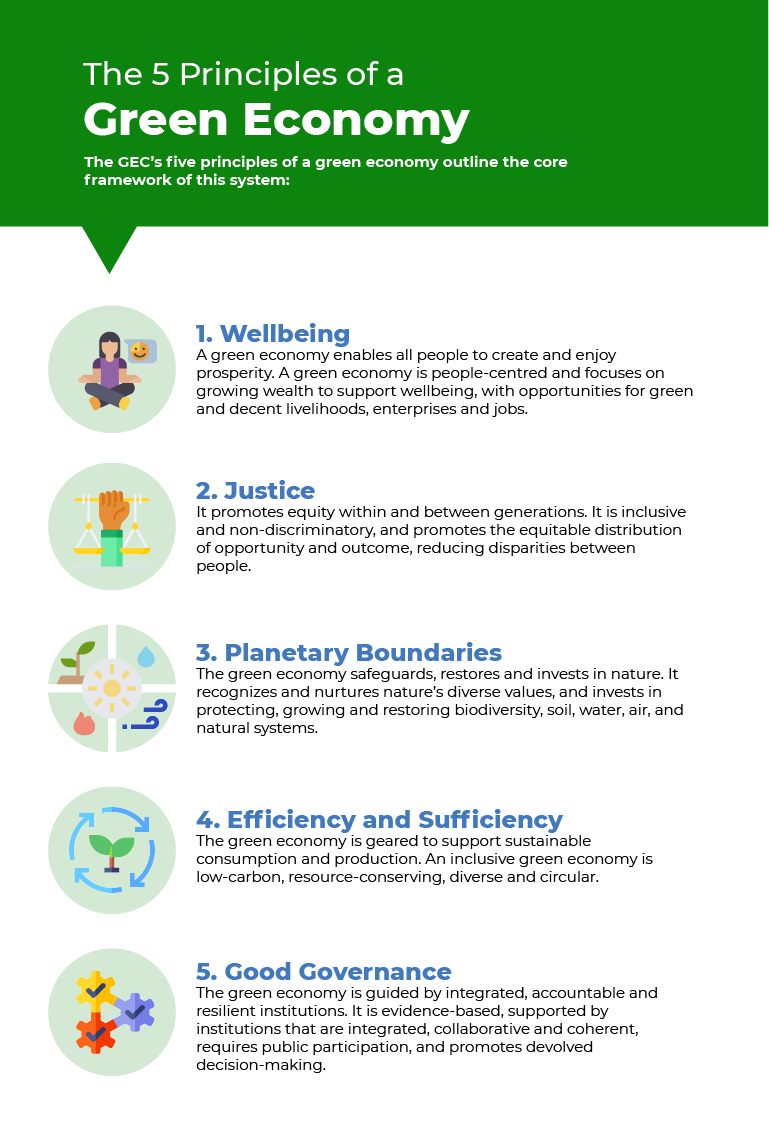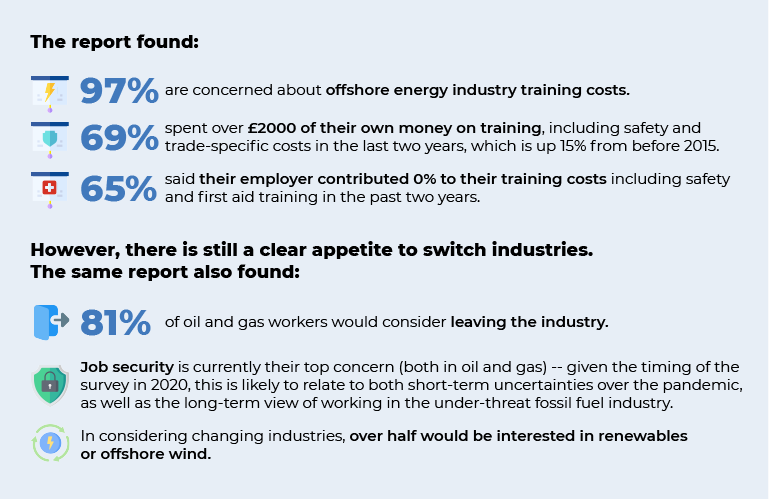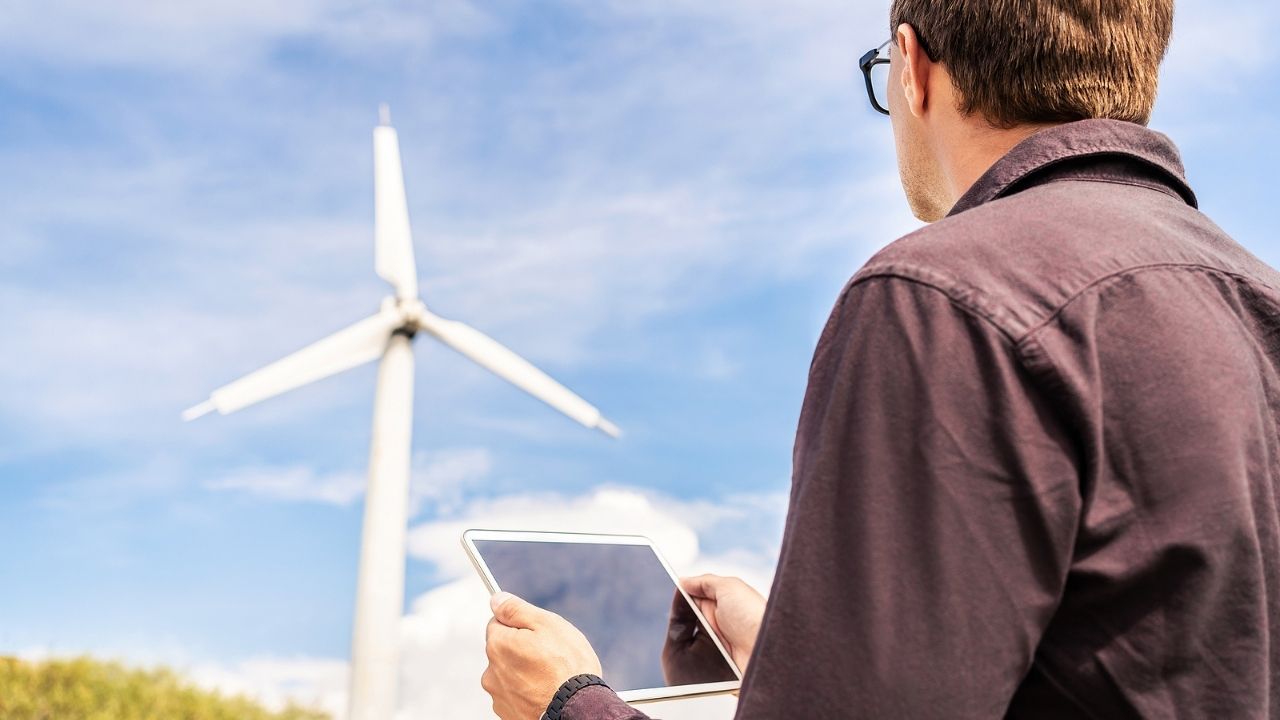- What is the green economy and why is it happening?
- How will the green economy impact the job market?
- How can workers prepare for these changes?
Q: What is the green economy?
A: A green economy is an economy built on sustainability and renewable energy sources rather than fossil fuels.
To build a healthy and sustainable future of work, we need a healthy and sustainable environment.
That goes for our local communities as well as the global environment.
After all, a sustainable environment is crucial in order to build businesses, create jobs, stimulate growth and enable people to enjoy healthier, happier lives.
As the International Labour Organization puts it, “The world of work needs environmental sustainability.”
That’s why the green economy is so important.
The term ‘green economy’ refers to the economy’s gradual move toward renewable energy, with less reliance on fossil fuels and non-renewable energy sources.
It is also linked to green jobs and efforts to build a better standard of living, globally.
While the opportunities for a greener, healthier and more sustainable future are clear, the transition poses significant challenges along the way.
How will the green economy impact jobs? What skills does it require? How will workers in fossil fuel sectors transition to the new requirements of renewable energy?
In this article, we address some of the challenges and opportunities that lie ahead as the world shifts toward a green economy, and what this means for the future of work.
What Is the Green Economy and Why Is it Happening?
What are the characteristics of a green economy?
A green economy is an economy built on sustainability and renewable energy sources rather than fossil fuels.
Here’s how the UN Environment Programme (UNEP) defines the green economy:
A green economy is defined as low carbon, resource efficient, and socially inclusive. In a green economy, growth in employment and income are driven by public and private investment into such economic activities, infrastructure, and assets that allow reduced carbon emissions and pollution, enhanced energy, and resource efficiency, and prevention of the loss of biodiversity and ecosystem services.
Why ‘green’?
The term ‘green economy’ was first coined in a 1989 report for the UK government, entitled Blueprint for a Green Economy (Pearce, Markandya and Barbier, 1989).
However, the link between the green economy and sustainable development has long been evident.
The global financial crisis of 2007-2008 was a turning point.
It was seen as an opportunity to “promote green economy initiatives as part of the stimulus packages being put in place to support the recovery.”
The green economy was also the central theme of the UN conference on Sustainable Development held in Rio in 2012.
Today, the term is used to describe a framework for “building economies that are fairer, greener and more resilient” [Green Economy Coalition], and discussion around sustainability has become a key part of the global agenda.
Why is the green economy happening?
Environmental damage cannot be ignored.
These challenges and crises are interconnected with climate change, biodiversity loss, growing inequality, and more.
According to the Green Economy Coalition (GEC), “our economic systems are not fit enough to deliver a good balance of environmental and social goals”, which is why we need to upgrade our economy to enable a more inclusive and sustainable future.
A green economy is designed to build a financial system with the purpose of delivering wellbeing and sustainability, set up in ways that safely serve the interests of society.
The 5 Principles of a Green Economy

The GEC’s five principles of a green economy outline the core framework of this system:
- Wellbeing: A green economy enables all people to create and enjoy prosperity. A green economy is people-centred and focuses on growing wealth to support wellbeing, with opportunities for green and decent livelihoods, enterprises and jobs.
- Justice: It promotes equity within and between generations. It is inclusive and non-discriminatory, and promotes the equitable distribution of opportunity and outcome, reducing disparities between people.
- Planetary Boundaries: The green economy safeguards, restores and invests in nature. It recognizes and nurtures nature’s diverse values, and invests in protecting, growing and restoring biodiversity, soil, water, air, and natural systems.
- Efficiency and Sufficiency: The green economy is geared to support sustainable consumption and production. An inclusive green economy is low-carbon, resource-conserving, diverse and circular.
- Good Governance: The green economy is guided by integrated, accountable and resilient institutions. It is evidence-based, supported by institutions that are integrated, collaborative and coherent, requires public participation, and promotes devolved decision-making.
Examples of the Green Economy
There are many different green economy examples.
An obvious one is Denmark, which is leading the world in slowing its growth in CO2 emissions. It is ranked as the world’s greenest country by the Environmental Performance Index (EPI).
More than 30% of Denmark’s energy needs come from renewables. It expects to reach 50% by 2030, and by 2050, Denmark aims to be 100% independent of fossil fuels altogether.
How is Denmark achieving its green economy aims?
For decades, Denmark has been reconciling economic growth with ambitious green policies, and has managed to decouple economic growth from its overall energy consumption.
As this chart shows, since 1990 Danish GDP has continued to increase while energy consumption has only increased by 6% and water consumption has decreased by 40%.
This proves that it is possible to create economic growth without using more energy.
There is no single road to a green and prosperous economy.
In Denmark’s case, it has taken decades of long-term planning, framework legislation, and broad political agreements.
It takes a holistic approach that requires a lot of collaboration across sectors. For instance, Denmark attributes its current green economy successes to a variety of collaborations:
- Collaboration between the water and electricity sector, where sludge from wastewater treatment plants is used to produce energy.
- The cogeneration of heat and electricity, where surplus heat from electricity production is used to heat water piped into the district heating system.
- In cities, waste from citizens is used to produce heat and electricity.
- Climate adaptation solutions above ground prevent flooding in the cities, while simultaneously creating greener and more liveable cities.
- Denmark’s electricity trade with neighbouring countries enables it to secure supply and high integration of renewables into its energy system.
Despite its world recognition as a leading green economy, Denmark’s model is not (yet) perfect.
The OECD notes that while Denmark is “a leader in eco-innovation” there are areas that require significant work, including waste generation, which “remains the highest in the OECD area”. It also notes that “many bodies of water do not reach good ecological status”.
Denmark acknowledges that it has work to do, and that it requires “a genuine paradigm shift in Danish energy policy in the coming years” in order to fulfil its 2050 vision.
But, Denmark is proving that green business is good business, and its sustainable model serves as a beacon for the rest of the world to follow.
Global Initiatives and Green Deals
In many cases, green economy growth is happening with the help of a Green New Deal.
A Green New Deal aims to create jobs, reduce economic inequality and address climate change, by focusing on transitioning to more sustainable and environmentally friendly sources.
In 2009, a report commissioned by UNEP — ‘A Global Green New Deal’ — was published in response to the multiple global crises of 2008.
It proposed policy actions that would stimulate economic recovery and at the same time improve the sustainability of the world economy.
Since the early 2000s, and especially since 2018, numerous other proposals for a ‘Green New Deal’ have arisen both in the U.S. and internationally.
In the U.S., the Green New Deal was initially introduced in 2019, and again in 2021.
The resolution seeks to eliminate U.S. greenhouse gas emissions within a decade and transition the economy away from fossil fuels.
Joe Biden’s victory in the US presidential election is expected to generate positive momentum for the energy transition, as Biden is committed to tackling climate change and supporting clean energy.
So if you’re wondering, ‘Is the green economy good?’
Potentially, yes — because it is designed to reduce negative environmental impacts from fossil fuels while opening up new job opportunities based on renewable energy in the future.
That being said, there is still plenty of opposition and challenges ahead, particularly in regards to the wage floors involved in the task.
One of the biggest concerns is its impact on jobs, which we’ll explore next.
How Will the Green Economy Impact the Job Market?
Transitioning to a more sustainable economy has clear advantages, but there are concerns over how it will impact the jobs market.
What are the challenges of the green economy?
The major challenges to the green economy are the sweeping infrastructure changes involved and the replacement and creation of well-paying jobs.
As the world moves to a greener economy, a report by the International Labour Organization (ILO) — Greening with Jobs — estimates that 6 million jobs will be lost, including in the areas of petroleum extraction and refinery, coal mining and production of electricity from coal.
However, if we do nothing, or if we fail to transition to a greener economy, the same report estimates that 72 million full-time jobs will be lost by 2030.
This is based on projected temperature increases and environmental degradation, which impacts jobs and working conditions to the point where heat stress and temperature increases will lead to shorter available work hours, particularly in agriculture.
In contrast, providing the right policies for a greener economy are put in place, the ILO claims that 24 million new jobs could be created globally by 2030.
“Environmental sustainability is not a job killer, as it is sometimes claimed. On the contrary, if properly managed, it can lead to more and better jobs, poverty reduction and social inclusion.” — Juan Somavia, ILO [2012]
What Are Green Economy Jobs?
Definitions vary, but this typically refers to jobs that have a positive impact on renewable energy, electric transport, energy efficiency, or nature conservation.
Green jobs are not just about building wind farms or recycling construction waste.
As more companies and sectors transition to low-carbon models, every job has the potential to become ‘green’. Recruitment, purchasing, brokering, insuring, consulting, designing, researching, training… the list goes on.
Here are 10 green jobs as listed by The Greener Deal:
- Urban farmers

- Solar photovoltaic installers

- Wind turbine specialists

- Green home builders (green retrofitters)

- Green designers, planners and architects

- Sustainability consultants

- Environmental scientists

- Wave energy producers

- Hydropower technicians

- Environmental engineer

These are just 10 job roles in the green economy.
Now consider all of the analysts, developers, programmers, managers, executives, assistants, and apprentices — to name a few — involved with each and every one of these roles.
As the green economy grows, it’s easy to see how jobs can evolve and grow with it.
Is the Green Economy the New Gig Economy?
As with every industry evolution, change can be a slow-turning wheel.
Initially, jobs may focus on the transition from fossil fuels to renewable energy sources.
For example, there will be a need for the construction of new power plants. This will inevitably open up a lot of opportunities for construction workers.
However, these roles may be temporary. Once the plant is constructed, the initial contract will come to an end.
And depending on funding available, there could be discrepancies in pay compared with salaries from traditional companies operating within fossil fuel sectors.
Does this mean that the green economy is essentially a gig economy?
The gig economy is characterised by short-term jobs or ‘gigs’. Instead of a regular wage, workers get paid for the ‘gigs’ they do, such as a food delivery or a car journey.
In a green economy there will undoubtedly be gig workers, just as there are now.
For example, in a survey of over 1,300 oil and gas workers in the UK, 74% of respondents are employed ad-hoc as contractors rather than as ‘core crew’ employees.
Some people prefer the flexibility of these short-term roles, or see it as an opportunity to earn extra money or fill in an employment gap.
However, some employers provide temporary or ‘gig’ recruitment as it offers them the flexibility to make changes to job roles or conditions with little or no notice. There is ongoing concern over this approach, which is seen as worker exploitation.
Whether there are more or less gig workers in the future will depend on the development of green jobs and the implementation of green economy policies.
How Can Workers Prepare for These Changes?
As with any large-scale evolutionary change that targets long-term prosperity, the green economy has a lot of potential for new, skilled positions to emerge.
However, as new green jobs begin to materialise, there may not be the appropriate skills readily available to keep up with demand.
There is also the challenge of transitioning workers from one sector to another.
For example, in the UK, a survey of 1,383 offshore oil and gas workers (approximately 5% of the offshore workforce) in September 2020 revealed some of the significant barriers workers are facing.
In particular, “the vast majority” of respondents identified training costs as a major barrier to successfully transitioning to other areas of the energy sector, with many workers paying thousands of pounds to complete their own training courses.

The report concluded that there are “inadequacies and issues” around training infrastructure for offshore workers, and that this is a growing problem.
This is one example of the skills gap that exists as the world transitions to a greener economy.
Upskilling of the workforce is essential as industries evolve, and individuals will need retraining and financial support to make that viable.
“Fundamental Skills”
The green economy requires a vast range of skills, ranging from the mechanical to the analytical.
Interestingly, amid these changes, the most valued skills are considered to be “fundamental skills” – active listening, speaking, critical thinking, and reading comprehension.
In other words, it is our human skills that are in-demand.
“Even as newer and greener occupations prioritize analytical skills and revive the need for mechanical skills in some cases, they share one essential trait with older occupations. Regardless of which group of occupations is examined, active listening, speaking, critical thinking and reading comprehension feature at the top of the list of skills ratings. In other words, preparation in fundamental skills remains the common currency in the workplace.” — Pew Research, 2020
What can workers do now?
Workers should stay up to date with developments within their industry in order to learn about new opportunities for retraining or skills utilisation.
For instance, in the report referencing oil and gas workers, the organisations that commissioned the report (Friends of the Earth Scotland, Platform, Greenpeace, RMT and Unite Scotland) are campaigning for solutions to the skills gap.
It’s also important for workers to begin learning new skills to equip themselves for the transition to the emerging green economy.
For instance, workers who understand the logistics of planning and implementing solar farms will be in high demand as infrastructure changes occur.
As these job roles emerge, there will undoubtedly be opportunities for contractual or ‘gig’ work.
Embracing gig work may be a way of getting ahead of the emerging green economy, and learning the skills necessary to succeed moving forward.
But workers should do so with as much research and planning as possible.
While flexible roles might provide the opportunity for immediate work and experience, the obvious downside is the potentially short lifespan of the work.
As with any short-term job, workers planning on taking temporary positions should always consider what comes next. Whether they can utilise this experience and continue onto other related jobs, or transition to another field entirely, having a plan will be crucial if they are to avoid unemployment once the project is complete.
Conclusion
The future of work may be green. But what about right now?
The green economy is coming at a time when the world is navigating the pandemic, and seeking to emerge with the help of a green and sustainable recovery.
In the words of Paula McGinnell from Cyan Finance, which provides finance to businesses and projects in the green, sustainable and socially positive economy:
“Green jobs build resilience, and the economic opportunity they provide is the largest we’ll see in our lifetime.”
McGinnell notes that demand for sustainable business is rapidly increasing, but there are still many hurdles to overcome.
Top of the list is skills, particularly as workers seek to transition from traditional industries reliant on fossil fuels to one focused on cleaner energy.
However, while there are many potential issues facing those who work to transition the country’s energy to renewable sources, there are also opportunities.
“With its emphasis on the environment and the sustainable use of resources, the green economy has stimulated employment in existing engineering and production jobs, ranging from industrial engineers to electricians…” — Pew Research, 2020
Gaining new skills — whether reskilling, upskilling, or learning from scratch — is the core of our successful future as we face this economic shift together.
A greener economy means a greener future, and the more people, businesses, and governments that can innovate and build solutions to sustain our environment, the more we can preserve a healthier future for everyone.


 Dr. Gleb Tsipursky – The Office Whisperer
Dr. Gleb Tsipursky – The Office Whisperer Nirit Cohen – WorkFutures
Nirit Cohen – WorkFutures Angela Howard – Culture Expert
Angela Howard – Culture Expert Drew Jones – Design & Innovation
Drew Jones – Design & Innovation Jonathan Price – CRE & Flex Expert
Jonathan Price – CRE & Flex Expert













